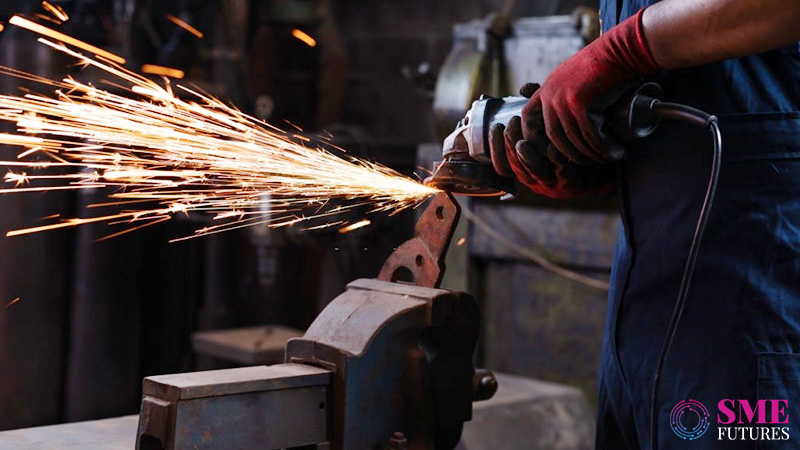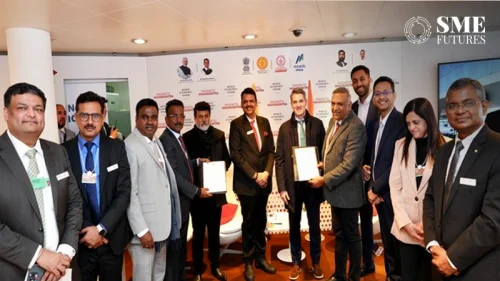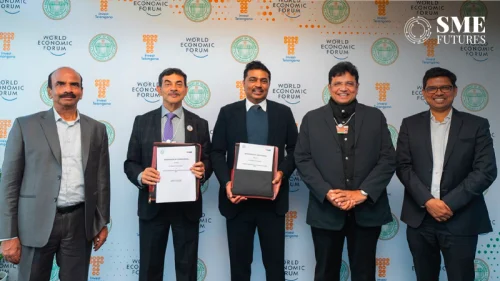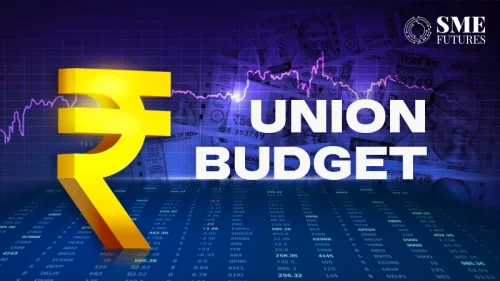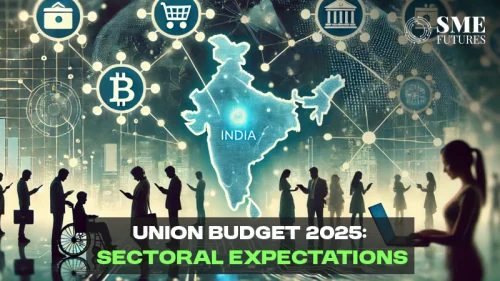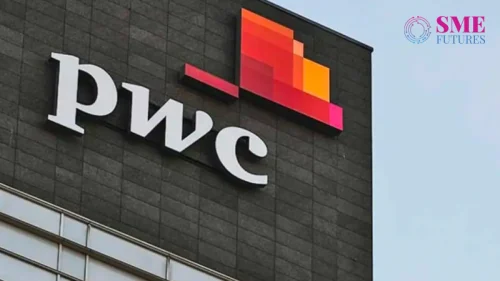So far, the manufacturing sector has made a significant contribution in getting the Indian economy back on track. The PLI scheme has given a much-needed boost to the sector. Yet, there are plenty of challenges still.
Despite all the efforts, the economy shrank by 7.3 per cent in the previous fiscal year. Even more so, India’s Manufacturing Purchasing Managers’ Index (PMI) fell from a high of 57.6 in November to 55.5 in December 2021.
Post sharing the PMI figures for December, IHS Markit stated that though these figures indicate a rise in business confidence, the overall optimism has gone down. One of the reasons being the dampened sentiments due to COVID-19. Secondly, the industry is concerned about supply-chain disruptions and inflationary pressure.
Even former RBI Governor Raghuram Rajan in his pre-budget note, penned his concerns over the weak consumption growth and the financial stress that the MSMEs are experiencing including the very tepid credit growth. Rajan also advised the government to do more to avoid a K-shaped recovery.
India Inc. unanimously agrees that this is only possible if the government focuses more on the MSME manufacturing sectors. Now with the Union Budget about to be announced, the manufacturing segment is seeking massive support and a host of schemes on the lines of the PLI across industries, especially for the manufacturing sector.
Top demands of the manufacturing sector
This Union Budget is expected to lay a roadmap for the healthy growth of the manufacturing sector. The stakeholders mostly want measures around these top areas—the expansion of the PLI scheme to more sectors, a relaxation in corporate tax and employment generation.
According to a pre-budget survey by KPMG, over 83 per cent of people favoured an expansion of the PLI scheme to cover other sectors. While with GST revenues on the rise, respondents also felt that the government should not change the current GST tax slabs.
At the same time, stakeholders also want to rationalise corporate tax. Currently, the concessional corporate tax rate of 15 percent for new manufacturing companies comes with a condition that manufacturing/production should commence before 31 March 2023.
Given the COVID-19 pandemic and the resultant economic disruptions, a majority of the respondents expect the government to extend the timeline for the commencement of manufacturing /production beyond 31 March 2023.
“Now that we are hoping for some stability, the new Union Budget for 2022 must focus on creating more demand and building employment opportunities across various sectors that have been adversely affected and have witnessed a drastic dip in hiring,” says RP Yadav, Chairman & Managing Director, Genius Consultants.
He adds that the PLI scheme, along with the ‘Aatmanirbhar Bharat’ initiative, if continued to be promoted and upscaled, can help the manufacturing sector as well as many other industries.
The budget should also focus on improving and strengthening the existing medical infrastructure and stabilising the decisions about the policies. Throwing focus on these specific areas could help increase the GDP by 9 per cent for the year 2022 and 8.5 per cent for 2023 respectively and may also curb the fiscal deficit by 4.5 per cent for the year 2025-26.
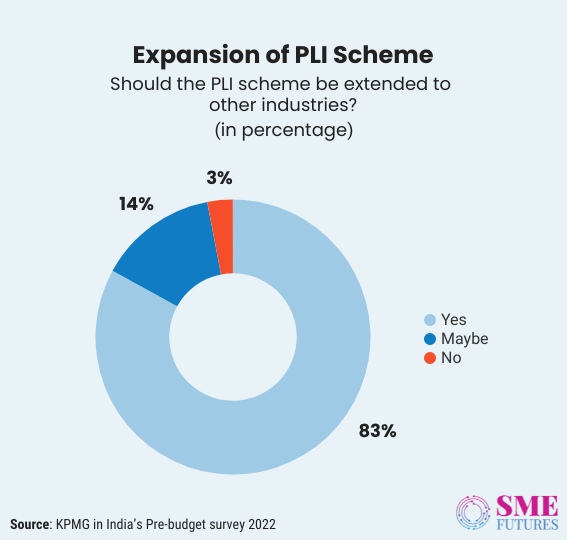
More efforts are anticipated
Kulmani Gupta, Advisor to the Indian Industries Association (IIA) says that so far, the support and subsidies to the manufacturing sector have yielded incredible results. But upon observing the considerable growth in GDP and rising exports, India should further work on industry automation and encouraging manufacturing excellence to build up the scale.
According to him the challenge is the cost of industrial land and the infrastructure in major manufacturing hubs is not yet affordable.
“Though the government has done a lot, yet more efforts are needed. Industrial areas of small towns may be promoted by providing extra incentives to decongest the bigger hubs. Self-approval and ease of doing business should be taken to the next level to compete with the world. Post pandemic, it is a golden opportunity for India to attract the world and become a manufacturing giant,” he says.
Shyam Steel Industries’ Director, Lalit Beriwala, couldn’t agree more. He strongly advises the government to pay close attention to MSMEs, as they are critical to the growth of the manufacturing industry. “Improved performance of the MSME sector is vital for achieving global benchmark efficiency and the quality of the products being manufactured in India, as it supplies goods and services to big industrial enterprises,” he says.
Measures for steel industry
As a stakeholder in the Indian steel industry, Beriwala suggests that the government should consider the allocation of smaller mines of iron ore and coal through the e-auction process amongst the MSMEs alone, as it will protect them from the competition from bigger businesses. Also, it will boost steel manufacturing.
Abhyuday Jindal, Managing Director of Jindal Stainless urges government to restore countervailing duty (CVD) imposed on stainless steel products from China and Indonesia.
These CVDs were imposed in September 2017 and in October 2020, respectively, after detailed investigations by the Directorate General of Trade Remedies (DGTR), Ministry of Commerce, which conclusively proved the existence of non-WTO compliant subsidies in these countries.
Ever since their suspension, imports shot up by 300 per cent and 339 per cent from China and Indonesia, respectively, in the first half of this fiscal compared to the average monthly imports of the last fiscal. Today, Indonesia, with a manufacturing capacity of 55 lakh tons aided by Chinese investments, and with domestic consumption of only 2 lakh tonnes, has displaced India to become the second-largest manufacturer of stainless steel in the world.
“Once again, there is uncertainty in the business and investment climate in the stainless steel industry. We are already witnessing job losses in MSMEs, as well as the transformation of small manufacturers into traders. In reality, the dream of ‘Atmanirbhar Bharat’ is taking the form of a ‘Aashrit Bharat’,” he says.
Dr. RC Mansukhani, Chairman, Man Industries (India) ltd, is another steel industry stakeholder who advocates lowering import duties on steel and all other metals in the upcoming budget to help industries grow, which has been hampered by rising input costs.
“Steel pipe consumption in the oil, gas, and water sectors will increase this year. This is due to the government’s infrastructure push, which has resulted in a broader allocation of funds for the ‘Nal se Jal’ Scheme. In addition, demand from construction, engineering, and other industries has increased. So, we anticipate an announcement of lower import duties,” he says.
He also expects the government to implement reforms centred on import alternatives in order to boost domestic manufacturing and self-sufficiency. Furthermore, higher tax rates for individuals should be reduced in order to boost Capex and domestic investment, which will result in more job opportunities.
Extend FAME II benefits
To push India’s EV momentum, the government has initiated the FAME policy and the PLI scheme for EV manufacturing. Given this, the EV makers are very optimistic about the announcements for the EV automobile sector. Most of them are expecting this budget to focus on sustaining the growth momentum.
Dr. Amitabh Saran, CEO of Altigreen Propulsion Labs hopes that the budget will keep on encouraging the EV manufacturers so as to boost the AtmaNirbhar Bharat concept, he says, “This year, we expect announcements that will address the existing challenges.”
A few grey areas where the EV sector needs support include—a reduction in the criteria for being eligible for the PLI scheme to support the young companies; support to the sale/renting of charging infrastructure; support to battery cell R&D and manufacturing; a push to the nationalised banks for the financing of EVs, and a small budget to provide guarantors for young OEM vehicle financing.
“We also expect the rationalisation of taxation policies, for example, the government should encourage EV buyers by extending FAME- II (until battery manufacturing is indigenised at a commercial scale) and by giving them additional relief or benefits on a purchase like those given to 2 wheelers. Extension of FAME-II benefits for retrofits and their inclusion in the scrappage policy would also be welcome,” he points out.
The EV segment is playing a crucial role in achieving sustainable development goals and encouraging announcements pertaining to it can position India as a leader in the global EV market. According to a market report by RBSA Advisors, India’s EV market is strongly gaining ground and is expected to reach $150 billion by 2030.
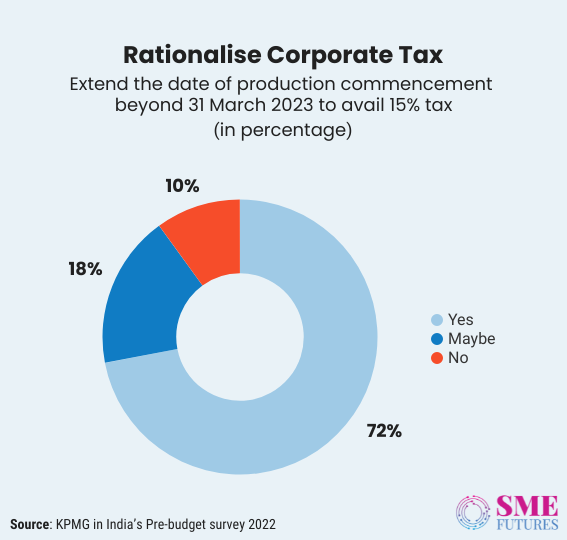
Measures to mitigate chip shortage
Due to the global chip crisis, industries in India too are facing delays and manufacturing constraints. Which has created a slump in several industries. However, acknowledging India’s potential in the ESDM sector, the government has already announced a PLI scheme for semiconductor manufacturing.
Alok Dubey, Chief Finance Officer, Acer India anticipates that steps will be taken to encourage sustainable growth and upgrading digital infrastructure- like 5G, edge computing, and secured data management in India. “The comprehensive program for the development of a sustainable semiconductor and display ecosystem in the country will provide a boost for making India a global hub of ESDM. But we would like to see reforms that will drive consumption and improve consumer demand,” he says.
Given the current semiconductor shortage, Pallavi Singh, VP, Super Plastronics (SPPL) urges the government to aid the sector and formulate more schemes under the NPE in the form of subsidies.
“The NPE will reduce its dependence on foreign nations if it were to correctly subsidize those who are willing to bring the relevant infrastructure, especially WRT semiconductor/chipset manufacturing to India. This, ideally, should also be backed by tax subsidizing schemes to reduce the burden on an entity since the quantum of investment required is huge. The NPE can also be expanded to include and aid those already manufacturing consumer electronics in India as opposed to importing them,” she suggests.
Adding in his views, Vishwakumara Kayargadde, Co-Founder and COO of Saankhya Labs opines that Design Linked Incentives (DLI) is another element linked to the PLI scheme and has been beneficial for the design and fabless companies.
“We are definitely hopeful of an MSME-centric budget. This will also help the MSMEs working in the deep tech space to engage in product R&D and manufacturing. Further, to encourage the manufacturing of indigenously designed products, the government should also look at relaxing tax burdens, and provide tax exemptions in areas such as customs duty,” he comments.
Reduction in cost and customs duty
The industry is also hoping for a reduction in raw material prices and a waiver of customs duty on imported inputs to make components. Singh of SPPL opines that since there are no open cell manufacturers in India and the viability of setting up a plant is far from certain; the Indian government should take this into consideration.
Pallavi comments, “They should reduce the customs duty on open cells to 0 per cent from the current 5 per cent. Had the same been present in India with imports providing competition or driving up open cell prices, it would still be reasonable to levy this duty. With the absence of the product because of the sheer lack of a facility, Indian manufacturers of televisions should not be made to pay for it. This will help to promote domestic manufacturing while also keeping our prices competitive should we aim to become an exporting country for consumer electronics.”
Counterfeits are still a roadblock
For years, the manufacturing of counterfeit goods and illicit trade have hampered India’s economic well-being. Not only are consumers duped, but the process also reduces valuable tax revenue and business profits. According to sources, the illicit market in seven select manufacturing sectors, including mobile phones, FMCG, tobacco, and alcohol, has resulted in a loss to the Indian exchequer of Rs 39,239 crores. Apart from the socioeconomic losses, it also led to the loss of 16 lakh jobs for young people in FY18.
Given this, it is critical to develop a stronger framework to combat counterfeiting to assist struggling businesses.
Speaking on the subject, Nakul Pasricha, President of the Authentication Solution Providers’ Association (ASPA), a non-profit organisation, believes that including anti-counterfeiting and traceability provisions in the policy framework can have a significant positive impact.
“It will help the government to patch the leakage of important resources. National authentication and traceability projects have been trending internationally for some years now, with China, Brazil, Turkey, the USA, and the EU being the pioneers in this area. It has helped these countries to reduce the shadow markets in many industries, improved tax collection, and reduced the losses incurred by businesses due to counterfeit products and illegal trade. As a country, India should also look up these measures to join the league of advanced digital economies,” he asserts.
Demand from the Incense industry
In recent years, the agarbatti segment has grown at a 10 per cent annual rate. So has the bamboo-free dhoop market, which is expected to grow at a CAGR of over 10 per cent. Given that India is the largest exporter of incense sticks, with exports to over 150 countries, including the top markets of the US, the UK, Malaysia, and Nigeria, stakeholders are looking at the Union Budget with optimism.
Anshul Agrawal, Managing Partner, Mysore Deep Perfumery House (Zed Black) is confident that the government will take the necessary steps to put India on the global manufacturing map.
However, he points out a few areas that the government should address. “The centre should work to enhance export competitiveness, ensure competitive import tariffs and regulate the cost of raw materials, especially of the paper board that is used in packaging, which has gone up tremendously since the past year,” he says.
Agrawal also points out that the PLI scheme, that has been a game changer is here to stay. So, may be industries will see more announcements around it. “The scheme is easy, transparent, and clear to understand for domestic businesses. That is here to stay for bringing investment in India and for boosting manufacturing and exports,” he elaborates.
Packaging woes of industries
Manufacturing industries depend heavily on packaging.
However, lately packaging prices have significantly surged on the back of demand-supply constraints and an increase in the price of paper and raw material which has led to the price inflation of various products.
For the sake of the consumers, the industry is urging the government to address packaging price inflation.
“It will be great if the centre can regulate the pricing of paper board, as it will help the industry in a big way. This will promote the “Make in India” initiative and will provide cost competitiveness to the domestic manufacturers,” urges Agrawal of Mysore Deep Perfumery. He tells us that as an agarbatti manufacturer sells over 15 lakh packs every day, they rely heavily on packaging for the launch of their new products.
On the same note, Manish Aggarwal, Director at Bikano & Bikanerwala Foods Pvt ltd. also points out the rising costs of raw and packaging materials.
This has forced the industries to hike prices, he says.
“We need help in tackling high inflation levels and also in the digitalisation of rural areas. Online is the way ahead and for the industries to be able to leverage this opportunity, digitalisation is key,” he asserts.
Recycled fibre (raw material for packaging) rates have jumped from Rs 10 per kg pre-COVID-19 to Rs 30 per kg now, which has placed an extra burden on the MSME manufacturing units.
In addition to these measures, industry stakeholders in general are optimistic about the country’s digital momentum. However, they expect the government to rationalise GST rates, compliance processes, FDI policies, and ride the buoyancy revenue curves in this budget.

